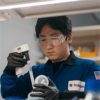Building the bioeconomy across America

Our first Bioforge was built on top of an old polyethylene wax distillery that exploded and blew out every window in a quarter-mile radius. This industrial refit epitomizes the growing bioeconomy, which is poised to revive the kind of postwar manufacturing we reminisce about today.
But what is the bioeconomy? It’s the harnessing of biology to produce everything from burgers to silk to chemicals in big steel tanks. It’s using plants, microbes, fungi, and cells to account for over five percent of U.S. GDP, creating good American jobs and meeting climate goals too.
Last year, the White House set a bold goal to meet at least 30 percent of U.S. chemical demand via sustainable biomanufacturing. The chemicals industry is one of the world’s most carbon-intensive operations, consuming approximately 10 percent of the world’s fossil fuels and emitting a staggering 3 billion metric tons of CO2e annually.
That’s where we come in, using biology to decarbonize the traditionally emission-intensive production of chemicals. To fulfill this goal, it’s time to build.
Location location location
People often think about places like San Francisco and Boston as biotechnology hubs (our R&D headquarters are actually in Houston), but it’s cities in the heartland and the rust belt that are the future of biomanufacturing.
Where else is there the land, workforce, and manufacturing know-how to put steel in the ground, cheap and fast? Not to mention access to sustainable agricultural feedstocks like corn?
Dextrose is a major feedstock for Solugen, allowing us to make clean chemicals from sugar, not fossil fuels. If you look at other biobased manufacturing companies, you’ll see we’re not alone in our preferred choice of feedstock.
Fortunately for us, the U.S. happens to be the largest producer, consumer, and exporter of corn in the world with production concentrated in the heartland. This makes states in Middle America ideal for scaling the bioeconomy from $1 trillion to $30 trillion. And it’s why Solugen’s newest Bioforge is based in Marshall, Minnesota, co-located with ADM’s corn processing complex and when operating at full capacity, estimated to reduce emissions by 10 million kilograms of CO2 per year.
There is an opportunity here to bring back the industrial heyday that defined the 20th century. Breaking ground on biomanufacturing plants will generate hundreds of thousands of green, high-paying jobs at all degree levels. Chemical engineers, bioprocess technicians, patent lawyers, welders, mechanics, pipefitters, truck drivers, and barge operators—the bioeconomy will create jobs for every kind of worker.
It’s what the White House has identified as the bioworkforce of the future, a workforce which ensures that cutting-edge products invented in America are made in America too.
The geopolitical race to own the future of biomanufacturing
Just as we are ramping up biobased production, so too are our friends and foes abroad. Everyone is reckoning with the fact that biology is set to create winners and losers in an economic boom over the coming decades.
Strengthening the bioeconomy is thus a matter of national security. India and China have already crafted long-term plans to use biotechnology to dominate the global stage and own biobased supply chains.
If we don’t take proactive measures to boost the bioeconomy here at home, the United States will fall behind.
The reality is that China, especially, is already outspending us in private and public investment. In 2019 alone, China directed at least $4 billion more dollars than the U.S. to biobased R&D and critical infrastructure expansion which is sure to translate exponentially into manufacturing output.
We must take swift action to prevent biomanufacturing from going the way of the electronic revolution and succumbing to an “innovate here, produce there” model (take iPhones, for example, famously designed in California and made in China).
While the U.S. government has made considerable investment in discovery science and R&D, it’s not enough. We need innovative funding initiatives to put steel in the ground, scale up production, and stake our claim as a geographic center of this new era of biomanufacturing.







